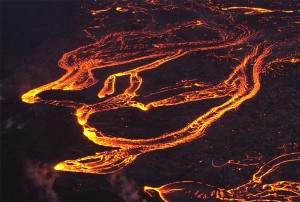 Video courtesy Mick and Ann Kalber, of Tropical Visions Video
Video courtesy Mick and Ann Kalber, of Tropical Visions Video
Lava continues to erupt from about a dozen new points along a crack in the west flank of Pu’u ‘Ō’ō, report USGS geologists with the Hawaiian Volcano Observatory.
Lava was moving much slower the day after the new lava flow burst out of the east rift zone… and it appears as if lava has begun to pond at the eastern end of the Kamoamoa fissure area.
The video above is raw footage filmed by the famed Tropical Visions vulcanographer Mick Kalber, who took to the sky the day of the eruption – when the new lava flow was still vigorous – in time to catch the tale end of the “magic hour”, when the glow of the molten rivers of rock are bright.
Today, the Hawaiian Volcano Observatory posted this Kilauea update:
The walls of Pu`u `O`o Crater continued to collapse yesterday including a block immediately to the left of the webcam which dropped in overnight. A trickle of lava returned to the very deepest part of the collapsed crater floor yesterday morning and was visible in the webcam overnight. During yesterday’s overflight, the depth of the collapse was measured at about 75 m (245 ft) below the east rim. The flows that gushed out of the west flank vents on August 3rd remained active but with the outer limits of activity retreating back toward the sources; in other words, lower effusion rates weren’t allowing the active lava to travel as far from the vents before solidifying. The flows remained entirely within Hawai`i Volcanoes National Park and pose no direct hazard to any developed areas.
The GPS network around Pu`u `O`o Cone recorded slow contraction across the cone overnight. The tiltmeter on the north flank of Pu`u `O`o Cone recorded continued deflation. Seismic tremor levels were low. The most recent (preliminary) sulfur dioxide emission rate measurement was 3,100 tonnes/day on August 4, 2011, from all east rift zone sources.
Meanwhile, officials at Hawaii Volcanoes National Park reopened Chain of Craters Road at 4 p.m. Thursday, after a 24-hour closure resulting from the new eruptive activity. Park rangers are stationed near sea level at the bottom of Chain of Craters Road, at Pu‘u Huluhulu and at Jaggar Museum to inform visitors of the latest conditions and best viewing opportunities.
Scientists say the volume of erupted lava has already equaled, or exceeded, the volume of the Pu`u `O`o crater collapse, so the flow is possibly being fed directly from the rift zone.
No residential homes are in immediate danger, officials say.

by Big Island Video News12:46 pm
on at
STORY SUMMARY
Video courtesy Mick and Ann Kalber, of Tropical Visions Video Lava continues to erupt from about a dozen new points along a crack in the west flank of Pu’u ‘Ō’ō, report USGS geologists with the Hawaiian Volcano Observatory. Lava was moving much slower the day after the new lava flow burst out of the east […]